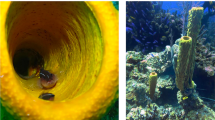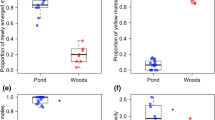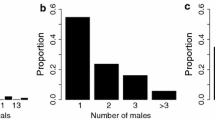Synopsis
Male beaugregory damselfish,Stegastes leucostictus, were provided with three types of artificial breeding structures to determine if they change habitats based on past or future reproductive payoffs. All three site types quickly lured males away from their natural sites. In comparison to those living on natural sites, those using artificial sites were less likely to move to different areas and had a higher reproductive success. When given no choice, male reproductive success was correlated to structural type. A second experiment provided males with an additional structure after using the intermediate quality type for 2 months. Males would often initially use both sites but would eventually shift their spawning activity to the new site if it was of the same quality or better than the old one. However, males would not move if the new site was of inferior quality. When given a new site identical to the initial one, approximately half of the males shifted to the new site. There was no evidence that reproductive performance influenced a male's decision to use a new site.
Similar content being viewed by others
References cited
Bartels, P.J. 1984. Extra-territorial movement of a perennially territorial damselfish,Eupomacentrus dorsopunicans. Behaviour 91: 312–320.
Bisazza, A. & A. Marconato. 1988. Female mate choice, male-male competition and parental care in the river bullhead,Cottus gobio L. (Pisces, Cottidae). Anim. Behav. 36: 1352–1360.
Bradbury, J.W. & R.M. Gibson. 1983 Leks and mate choice. pp. 109–138.In: P. Bateson (ed.) Mate Choice, Cambridge University Press, New York.
Brawley, S.N. & W.H. Adey. 1977. Territorial behavior of the three-spot damselfish,Eupomacentrus planifrons, increases reef algal biomass and productivity. Env. Biol. Fish. 2: 45–51.
Brown, J.L. 1964. The evolution of diversity in avian territorial systems. Wilson Bull. 76: 160–169.
Hastings, P.A. 1988. Female choice and male reproductive success in the angel blenny,Coralliozetus angelica (Teleostei: Chaenopsidae). Anim. Behav. 36: 115–124.
Hixon, M.A. & W.N. Brostoff. 1983. Damselfish as keystone species in reverse intermediate disturbance and diversity of reef algae. Science 220: 511–213.
Holm, C.M. 1973. Breeding sex ratios, territoriality, and reproductive success in the red-winged blackbirds (Agelaius rhoeniccus). Ecology 54: 356–365.
Itzkowitz, M. 1977. Female mate choice in the pupfish,Cyprinodon variegatus. Behav. Processes 3: 1–8.
Itzkowitz, M. 1985. Aspects of the population dynamics and reproductive success in the permanently territorial beaugregory damselfish. Mar. Behav. Physiol. 12: 57–69.
Itzkowitz, M. & D. Makie. 1986. Habitat structure and reproductive success in the beaugregory damselfish. J. Exp. Mar. Biol. Ecol. 97: 305–312.
Irvine, G.V. 1980. Fish as farmers: an experimental study of herbivory in a territorial coral reef damselfish,Eupomacentrus planifrons. Amer. Zool. 20: 822.
Kodric-Brown, A. 1983. Determinants of male reproductive success in pupfish (Cyprinodon pecosensis). Anim. Behav. 31: 128–137.
Lenington, S. 1980. Female choice and polygyny in redwinged blackbirds. Anim. Behav. 28: 347–361.
Leonard, M.I. & J. Pickman. 1988. Mate choice by marsh wrens: the influence of male territory quality. Anim. Behav. 38: 517–528.
Lightbody, J.P. & P.J. Weatherhead. 1987. Polygyny in the yellow-headed blackbird—female choice versus male competition. Anim. Behav. 35: 1670–1684.
Lill, A. 1974. Social organization and space utilization in the lek-forming white-bearded manakin,M. manacus trinitatis. Z. Tierpsychol. 36: 513–30.
Orians, G.H. 1961. The evolution of blackbird (Agelaius) social systems. Ecol. Monogr. 31: 189–220.
Orians, G.H. 1969. On the evolution of mating systems in birds and mammals. Amer. Nat. 103: 347–361.
Pleszczyńska, W.K. 1978. Microgeographic prediction of polygyny in lark bunting. Science 201: 935–937.
Schmale, M. 1981. Sexual selection and reproductive success in males of the bicolor damselfish,Eupomacentrus partitus. Anim. Behav. 29: 1172–1184.
Siegel, S. 1956. Nonparametric statistics for behavioral sciences. McGraw-Hill, New York. 276 pp.
Verner, J. & M.F. Willson. 1966. The influence of habitats on mating systems of North American passerine birds. Ecology 47: 143–147.
Warner, R.R. 1987. Female choice of sites versus mates in a coral reef fish,Thalassoma bifasciatum. Anim. Behav. 35: 1470–1478.
Wiley, R.H. 1973. Territoriality and non-random mating in sage grouse,Centrocercus urophasianus. Anim. Behav. Monogr. 6: 87–169.
Yasukawa, K. 1981. Male quality and female choice of mate in the red-winged blackbird,Agelaius rhoeniccus. Ecology 62: 922–930.
Zar, J.H. 1984. Biostatistical analysis, 2nd Edition. Prentice-Hall, Englewood Cliffs. 620 pp.
Author information
Authors and Affiliations
Rights and permissions
About this article
Cite this article
Itzkowitz, M. Habitat selection and subsequent reproductive success in the beaugregory damselfish. Environ Biol Fish 30, 287–293 (1991). https://doi.org/10.1007/BF02028844
Received:
Accepted:
Issue Date:
DOI: https://doi.org/10.1007/BF02028844




